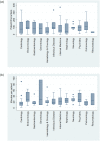Analyses of electronic health records utilization in a large community hospital
- PMID: 32609757
- PMCID: PMC7329072
- DOI: 10.1371/journal.pone.0233004
Analyses of electronic health records utilization in a large community hospital
Abstract
Introduction: The Electronic Health Record (EHR) has become an integral component of healthcare delivery. Survey based studies have estimated that physicians spend 4-6 hours of their workday devoted to EHR. Our study was designed to use computer software to objectively obtain time spent on EHR.
Methods: We recorded EHR time for 248 physiciansover 2 time intervals. EHR active use was defined as more than 15 keystrokes, or 3 mouse clicks, or 1700 "mouse miles" per minute. We recorded total time and % of work hours spent on EHR, and differences in those based on seniority. Physicians reported duty hours using a standardized toolkit.
Results: Physicians spent 3.8 (±2) hours on EHR daily, which accounted for 37% (±17%), 41% (±14%), and 45% (±12%) of their day for all clinicians, residents, and interns, respectively. With the progression of training, there was a reduction in EHR time (all p values <0.01). During the first academic quarter, clinicians spent 38% (± 8%) of time on chart review, 17% (± 7%) on orders, 28% (±11%) on documentation (i.e. writing notes) and 17% (±7%) on other activities (i.e. physician hand-off and medication reconciliation). This pattern remained unchanged during the fourth quarter.
Conclusions: Physicians spend close to 40% of their work day on EHR, with interns spending the most time. There is a significant reduction in time spent on EHR with training and greater experience, although the overall amount of time spent on EHR remained high.
Conflict of interest statement
The authors have declared that no competing interests exist.
Figures





Similar articles
-
Interaction Time with Electronic Health Records: A Systematic Review.Appl Clin Inform. 2021 Aug;12(4):788-799. doi: 10.1055/s-0041-1733909. Epub 2021 Aug 25. Appl Clin Inform. 2021. PMID: 34433218 Free PMC article.
-
Surgery Resident Time Consumed by the Electronic Health Record.J Surg Educ. 2020 Sep-Oct;77(5):1056-1062. doi: 10.1016/j.jsurg.2020.03.008. Epub 2020 Apr 16. J Surg Educ. 2020. PMID: 32305335
-
Documenting or Operating: Where Is Time Spent in General Surgery Residency?J Surg Educ. 2018 Nov;75(6):e97-e106. doi: 10.1016/j.jsurg.2018.10.010. J Surg Educ. 2018. PMID: 30522828 Free PMC article.
-
Vascular surgery residents spend one fifth of their time on electronic health records after duty hours.J Vasc Surg. 2019 May;69(5):1574-1579. doi: 10.1016/j.jvs.2018.08.173. J Vasc Surg. 2019. PMID: 31010521
-
The electronic health record and patient-centered care.Nurs Manage. 2020 Mar;51(3):6-8. doi: 10.1097/01.NUMA.0000654880.27546.6a. Nurs Manage. 2020. PMID: 32101941 Review. No abstract available.
Cited by
-
Interaction Time with Electronic Health Records: A Systematic Review.Appl Clin Inform. 2021 Aug;12(4):788-799. doi: 10.1055/s-0041-1733909. Epub 2021 Aug 25. Appl Clin Inform. 2021. PMID: 34433218 Free PMC article.
-
Using event logs to observe interactions with electronic health records: an updated scoping review shows increasing use of vendor-derived measures.J Am Med Inform Assoc. 2022 Dec 13;30(1):144-154. doi: 10.1093/jamia/ocac177. J Am Med Inform Assoc. 2022. PMID: 36173361 Free PMC article.
-
The Application of Projection Word Embeddings on Medical Records Scoring System.Healthcare (Basel). 2021 Sep 29;9(10):1298. doi: 10.3390/healthcare9101298. Healthcare (Basel). 2021. PMID: 34682978 Free PMC article.
-
The Paradoxes of Digital Tools in Hospitals: Qualitative Interview Study.J Med Internet Res. 2024 Jul 15;26:e56095. doi: 10.2196/56095. J Med Internet Res. 2024. PMID: 39008341 Free PMC article.
-
Association Between Proficiency and Efficiency in Electronic Health Records Among Pediatricians at a Major Academic Health System.Front Digit Health. 2021 Sep 6;3:689646. doi: 10.3389/fdgth.2021.689646. eCollection 2021. Front Digit Health. 2021. PMID: 34713161 Free PMC article.
References
-
- An Act Entitled The Patient Protection and Affordable Care Act. Public Law. 2010;111(148).
MeSH terms
Grants and funding
LinkOut - more resources
Full Text Sources

